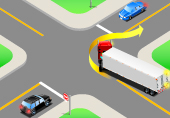Intersections
Stop intersections
Approach
Traffic Check – While approaching the intersection, you must monitor the surrounding traffic ahead. Watch for signage, observe traffic-control devices and monitor traffic flow. Respond to potential obstructions or delays that can prevent travelling through the intersection at a normal rate.
Speed – Gradual slowing allows for proper control of the vehicle. To ensure smooth traffic flow and equipment/shipment integrity, you must be aware of traffic conditions and execute smooth maneuvers.
Transmission/Gears – You must select a gear that is appropriate for the vehicle speed and load that allows the engine to operate within its normal r.p.m. range.
Lane Position – You must stay in the same lane approaching the intersection and not change position or lanes unnecessarily to ensure traffic flow is smooth and safe.
Stopping
Smooth Stop – You must be aware of traffic conditions and execute smooth manoeuvers.
Full Stop Roll – Making a full stop allows you enough time to thoroughly observe the traffic environment around the vehicle. You must keep the vehicle under control while stopped. Do not roll backward or forward.
Stop Position/Gap – Stopping in the proper legal stop position allows you to see the area ahead. Stopping in the intersection may impede the flow of cross traffic. Stopping with enough space between your vehicle and the vehicle ahead allows you to be able to maneuver the vehicle if necessary. You must move forward when adequate space becomes available ahead.
Traffic Check – While waiting, you must monitor the surrounding traffic ahead, beside and in the vehicle mirrors to alert yourself to any changes in traffic conditions.
Starting
Traffic Check – Before entering the intersection, you must monitor the surrounding traffic ahead.
Speed/Right-of-way – You must start vehicle movement within a reasonable time when permitted by the traffic light and/or the movement of the vehicle ahead. You must also enter and travel through the intersection in a reasonable time.
Both Hands/Gears – You must maintain a two-handed grip on the steering wheel. Situations where only one hand is on the wheel must be limited to times when it is necessary to operate other vehicle controls or make a gear selection.
Lane Position – You must follow the correct pathway upon entering and exiting the intersection. Do not change lanes or position in the intersection.
Traffic Check – Keeping a constant visual search through the vehicle mirrors will alert you to any changes in condition.
Through intersections
Approach
Traffic Check – While approaching the intersection, you must monitor the surrounding traffic ahead.
Speed – Maintain speed approaching the intersection to ensure there is not a disruption in traffic flow. If there is any cross traffic that might enter the intersection ahead, you must slow down or cover the brake.
Gap – Safe following distance must be maintained and adjusted to allow for a safe stop.
Lane/Position – You must stay in the same lane/ position as you approach the intersection to ensure traffic flow is smooth and safe.
Driving through
Lane/Position – You must stay in the same lane/ position as you travel through the intersections to ensure traffic flow is smooth and safe.
Both Hands/Gears – To maintain proper control of the vehicle, your hands should be on the steering wheel. Any necessary transmission shifts should be made prior to entering an intersection. Downshifting prior to an intersection may be necessary to avoid lugging the engine.
Traffic Check – Checking mirrors after clearing an intersection allows you to be continually aware of conditions so that necessary adjustments in speed and position can be made.
